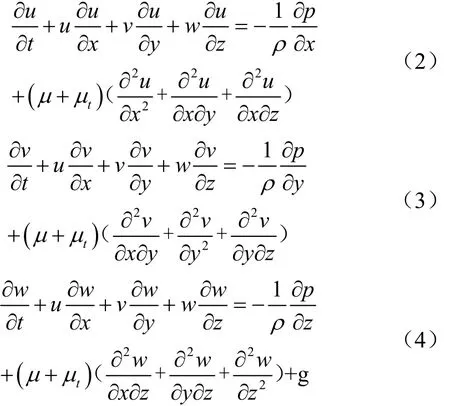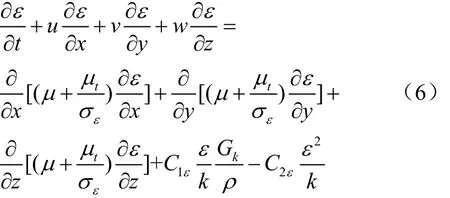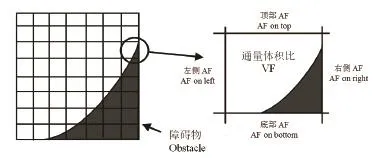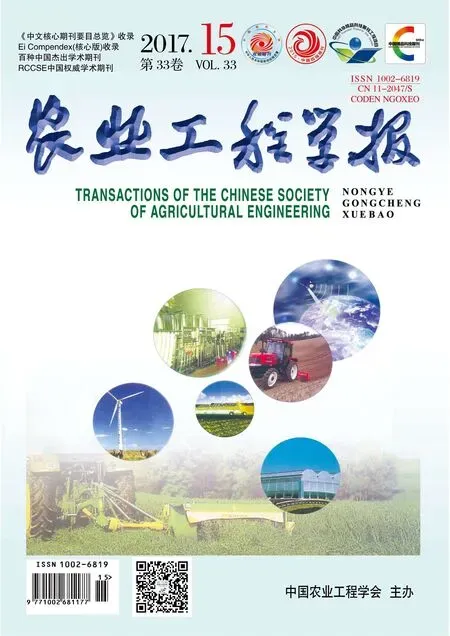仿自然鱼道中卵石墙对池室水力特性改善效果
李广宁,孙双科※,柳海涛,张 超,赵桂侠,郑铁刚
仿自然鱼道中卵石墙对池室水力特性改善效果
李广宁1,孙双科1※,柳海涛1,张 超1,赵桂侠2,郑铁刚1
(1. 中国水利水电科学研究院流域水循环模拟与调控国家重点实验室,北京 100038;2. 天津大学水利工程仿真与安全国家重点实验室,天津 300072)
仿自然鱼道是重要的鱼道布置方式之一,其特点是利用当地河床材料构建透水性卵石隔墙,以便更好地模拟出天然河流流态。为了定量分析透水性卵石墙对鱼道水力特性的改善效果,该文针对采用卵石隔墙与不透水隔墙的鱼道水力特性进行对比研究。结果表明:采用卵石墙的仿自然鱼道,池室内流态丰富,过鱼口处流速分布差异明显,表底流速差达到0.43~0.61 m/s为多种鱼类上溯提供了可能。池室内主流区分布较宽,紊动能较大达0.06~0.12 m2/s2,同时回流区减弱,有利于鱼类找到主流,实现上溯。卵石隔墙的不足之处是鱼道耗水流量相对较大达2.86 m3/s,在工程设计中需要综合考虑卵石墙透水特性与耗水流量之间的平衡关系,找到适宜的布置方案。该研究可为仿自然鱼道的水力设计提供参考。
鱼道;流速;流量;紊动能;耗水流量;数值模拟
李广宁,孙双科,柳海涛,张 超,赵桂侠,郑铁刚. 仿自然鱼道中卵石墙对池室水力特性改善效果[J]. 农业工程学报,2017,33(15):184-189. doi:10.11975/j.issn.1002-6819.2017.15.024 http://www.tcsae.org
Li Guangning, Sun Shuangke, Liu Haitao, Zhang Chao, Zhao Guixia, Zheng Tiegang. Improving effect of hydraulic characteristics of nature-like fishway with pools and cobblestone weirs[J]. Transactions of the Chinese Society of Agricultural Engineering (Transactions of the CSAE), 2017, 33(15): 184-189. (in Chinese with English abstract) doi:10.11975/j.issn.1002-6819.2017.15.024 http://www.tcsae.org
0 引 言
鱼道是帮助鱼类克服障碍物(如各种坝、堰、水闸)实现洄游上溯的设施[1]。鱼道分为技术型鱼道和仿自然鱼道,传统的技术型鱼道(如丹尼尔式鱼道、竖缝式鱼道等)的结构与流态相对单一,一般仅适合特定过鱼对象[2-6],而在实际工程中,同一条河流中需要保护的鱼类种类往往是多样的,且鱼类体型相差悬殊、生活习性和克流能力均不相同[7-9]。与传统技术型鱼道相比,仿自然鱼道构建的水流流态更接近于鱼类熟悉的天然状态,对鱼类往往具有更广的适用性和更高的过鱼效率[10-11]。
仿自然鱼道常采用水池-浅滩型式[12],其特点是采用梯级低堰将鱼道分隔成一系列的浅滩和深池,浅滩处水深较浅,流速较大,而深池内水流缓慢。池室型仿自然鱼道[13]是由这种鱼道发展而来,其特点是采用隔墙将鱼道分隔成多级水池,墙体通常为卵石墙(数块卵石堆叠而成的下宽上窄的墙体),卵石间缝这种分隔方式建造的鱼道,不但能够就地取材,利用漂石与天然河道床沙质,其水流还兼具水池式鱼道与技术型鱼道的双重特性。
目前,国外针对仿自然鱼道的水力特性已开展了一些研究[14-15],国内的相关研究尚处于起步阶段[16]。相比而言,国外学者比较重视研究各种块体障碍物对水流结构的影响,如Acharya等[17]针对球状障碍物、圆柱体和方柱体对水流结构的影响进行了模型试验,提出为了达到相似水流条件(弗洛德数Fr),球体的排列应该比方柱体的排列略微紧密一些,但是球体障碍物尾流区水面连接更加平顺。加拿大Alberta大学的Bretón等[18]研究了蛮石斜坡型鱼道中,蛮石间的流速与紊动强度等水力学参数,认为蛮石布置间距应该足够小,以遏制水流的加速,蛮石后尾流区的紊动能在一定的范围内变化(0.05~0.25 m2/s2)。Baki等[19-20]通过试验研究也得出了类似结论。Lacey等除了进行蛮石周围的紊流结构的试验研究[21],还实测了自然河流中典型蛮石周边的水流流场及紊动能等水力参数,发现在天然河道中蛮石后的尾流区内往往会形成较强烈的紊动[22]。在数值模拟方面,Tran等[23]利用浅水方程对蛮石斜坡型鱼道的水流特性进行了模拟,并进行了试验验证。何雨艨等[24]采用三维湍流模型对不同工况的蛮石斜坡型鱼道进行了数值模拟与试验验证,认为蛮石坎对缝排列比错缝排列具有更加合理的鱼道水力学特性。
本文采用Flow-3D软件,分别针对池室型仿自然鱼道内,采用卵石墙与不透水墙2种型式进行三维数值模拟,对两者的流态、流速、紊动能以及过流流量进行对比分析,以明晰两者水力特征的区别,为工程实际应用提供参考。
1 数学模型及验证
1.1 基本方程及求解方法
数值模拟采用standard k-ε湍流模型[25],该模型基本方程包括水流连续方程、动量方程、紊动能及其耗散率方程。
连续方程:

动量方程:

紊动能k方程:

紊动能耗散率ε方程:

式中t为时间,s;u、v、w 为x、y、z方向的时均速度分量为坐标分量,m/s;ρ为密度,kg/m³;μ、μt分别为黏性系数和紊动黏性系数,m2/s;p为时均压强,Pa;k为紊动能,m2/s2;ε为紊动能耗散率,m2/s3;Gk为紊动能产生项,各项紊流常数取值为Cμ=0.09,σε=1.3,σk=1.0,C1ε=1.44,C2ε=1.92。
液体自由表面采用VOF方法进行计算[26],通过计算水和气的体积分数来表征物体的形态,aa表示气体的体积分数,aw表示水的体积分数,其控制方程

模型求解采用有限体积法,二阶迎风格式,压力-速度耦合采用压力校正法,离散方程的求解采用GMRES法,时间差分采用全隐格式。
1.2 水体中障碍物的计算方法
计算模型中对于鱼道内具有一定透水性的卵石隔墙,采用FAVOR(fractional area/volume ratios)方法[27]进行定义。其原理是利用控制体积(网格)的6个面定义出可以有通量通过的局部面积与可自由通过体积的比率,若无可以让流体通过的面积则交界面不会有对流的通量,即FAVOR技术提供每个控制体积对于流体与障碍物交界面积的决定方法,网格与物体几何形状相互独立。尽管模型复杂,利用FAVOR技术也可以精确的表示其经过网格计算后的外观。引入VF=开放体积/单元体积,为网格可通过的通量比率,即通量体积比(fractional volume ratio),AF=开放面积/单元边面积,为各面可通过的通量比率,即通量面积比(fractional area ratio),网格内包含的灰色部分不会有通量通过,定义为障碍物,其余部分通量可通过,如图1所示,即以网格数目尺寸来表现原有体型的外观,并判断目前网格密度能否精确反应模型外观,避免因网格密度不足造成结果不精确。

图1 FAVOR技术障碍物定义示意图Fig.1 Schematic diagram of obstacle in FAVOR technology
1.3 模型体型及边界条件
本文以某拟建鱼道工程为基础开展研究,该鱼道工程主要过鱼对象为短须裂腹鱼,体长0.25~0.36 m,持续泳速0.59~1.17 m/s,突进泳速1.17~2.50 m/s。
鱼道数值模型的模拟范围包括水平段和池室段2个部分,水平段长15 m,池室段长40 m,池室段内共模拟5级鱼池。鱼道横断面为梯形,底宽5 m,顶宽12.5 m,边坡系数1.5,底坡1%。过鱼口位于河槽左侧,宽度1.0 m,隔墙采用交错布置型式,开口处出流方向与主槽呈45º夹角。研究中针对池室隔墙为卵石墙和不透水墙2种型式,分别建立数学模型。其中,透水卵石墙的卵石粒径为15~30 cm (当地鹅卵石粒径范围),共堆叠3层,底部大,顶端小,呈金字塔状,依靠自重保持结构稳定,总高1.8 m,底厚1.5 m,间距6.5 m;不透水墙体型是将卵石墙替换为的矩形隔墙,其高度、厚度和位置均保持不变。上述布置体型见图2a与2b。
计算模型采用嵌套加密的矩形网格,卵石墙附近网格尺寸0.05 m,其余部位网格尺寸0.1~0.5 m,网格总数约176万。计算网格划分情况如图2c所示。
计算过程中,模型入口和出口边界均设置为固定水深1.4 m;卵石墙与固壁均采用无滑移条件;卵石表面糙率取值,nl=0.015;鱼道边壁及池底糙率参照鱼道实际情况进行取值,np=0.03;卵石墙的孔隙率约12%,为纵剖面孔隙所占过流面积的比例。

图2 具有不同隔水墙的鱼道模型及其网格划分Fig.2 Fishways with different weir types and computational mesh
1.4 模型验证
卵石墙仿自然鱼道模型按重力相似准则设计,模型比尺λL=5,其结构布置形式与数值计算体型一致。仿自然鱼道原型底部糙率为0.03,由糙率比尺=λ1/6=1.308可知,模型基础糙率应为n=0.023。模型试验中,鱼道基础底面采用混凝土抹面,糙率为n=0.014,因此需要通过加糙试验,达到目标糙率。

由明渠均匀流公式可知,明渠糙率n可以表达为式中,A为体型明渠过水面积,m2;Q为流量,m3/s;R为水力半径,m;J为渠底坡降,%。根据模型横断面尺寸,可知过水面积A=h(b+mh)=h(1+1.5h);对应湿周;对应的水力半径为。由此可知,只要知道上游来流量Q和均匀流水深h,即可求解渠道糙率值n。试验中采用了正方形梅花加糙方法,颗粒直径2.5 cm,颗粒之间间距20 cm,测得模型糙率在0.022~0.023之间,满足试验精度要求。
试验中通过调节进口来流流量及出口尾门的开度,确保鱼道上下游水深均为1.4 m。试验测点布置如图3a所示,其中V1~V6为速度测点,位于各级池室过鱼口处,A1~E2均为水面线测点,位于隔墙上下游滞水区。图3b与3c为流速和水面线的试验与计算结果对比,流速误差小于0.1 m/s,水面线误差小于0.05 m,表明两者吻合良好。

图3 测点布置、流速、水面线计算值和试验值Fig.3 Arrangement of measuring points and comparison of simulation and test velocity values and water surface elevation
2 结果与分析
2.1 流态和流速
根据鱼道设计基本原则,鱼道池室内最大流速一般出现在过鱼口附近,其大小决定了鱼类是否能够成功通过该水池,其值以不超过鱼类的突进流速为宜[28-29]。过鱼口处的流速分布在垂向上应存在一定差异,可为不同游泳能力的鱼类的提供上溯通道。主流区分布范围不宜过于集中,两侧不宜形成大范围的回流区,以便于休息区的鱼类能够迅速找到主流,继续上溯,池室内休息区的水流具有丰富的流态,以接近自然河流形态为宜[11],可为鱼类提供休息、觅食场所与上溯通道。上述流场特性的影响因素较多,如隔墙类型,底坡变化,运行水深等等。
图4a和4b为卵石墙池室内表层与底层流场计算结果。分析表明,其主流流速呈现“表层小,底层大”的分布规律。卵石墙开口处流速分布具有“表层小,底层大,两侧小,中间大”的特征,如流速测点V3的表底流速在1.33~1.94 m/s,差值为0.61 m/s,测点V4的表底流速在1.43~1.86 m/s,差值为0.43 m/s。流速量值垂向分布范围较宽,且介于鱼类突进泳速1.17~2.5 m/s范围内,满足目标鱼类上溯需求。主流两侧未出现大范围回流区,有利于鱼类重新感应主流,继续上溯。
图4c和4d为不透水墙池室内表层与底层流场计算结果,相比而言,其流态分布更接近于技术型鱼道。首先,池室开口处流速分布上下基本一致。如流速测点V3的表底流速在1.56~1.64 m/s,差值为0.08 m/s,测点V4的表底流速在1.63~1.69 m/s,差值为0.06 m/s。流速分布较为单一。其次,主流区较为集中,休息区内分别形成了两个回流区,主流区与回流区之间存在流速接近于0的流速带,不利于鱼类发现主流,实现上溯。

图4 两种体型第3级水池(池3)流速分布Fig.4 Velocity distributions of third stage pool (Pool 3) in two schemes
2.2 紊动能
水流紊动能(turbulence kinetic energy, TKE)是反映水流紊动强度的指标,鱼道中水流保持适当的紊动强度,一方面有利于鱼类感应主流位置,同时也有利于增加水体含氧量,维持水质指标[30-31]。图5为卵石隔墙与不透水条件下,池室内表层与底层水体紊动能分布。计算结果分析表明,采用不透水墙的仿自然鱼道,池室内主流区紊动能仅为0.01~0.06 m2/s2;采用卵石墙的仿自然鱼道,受卵石不规则外形和缝隙间水流的冲击影响,池室内主流区紊动能可达0.06~0.12 m2/s2,便于鱼类感应到主流位置,实现上溯。卵石墙体型下,水体紊动能高于不透水墙池室体型,其原因主要是水体受到卵石不规则外形的干扰,以及卵石缝隙间水流的冲击所致。池室内表层水体紊动能高于底层,如卵石墙体型的表层紊动能最大值为0.12 m2/s2,底层最大值为0.06 m2/s2。究其原因在于,鱼道池室间存在水面落差,水流跌落对水体表面冲击所致。总体而言,采用卵石墙的鱼道体型,池室内紊动能较不透水墙鱼道体型有所增加。

图5 两种体型第3级水池紊动能分布Fig.5 Turbulent kinetic energy distributions of third stage pool in two schemes
2.3 过流流量
表1为两种鱼道体型各个池室的水位变化与耗水流量。在鱼道内水位保持相同(对应各级池室内的水深约1.4 m)的条件下,不透水墙鱼道体型的耗水流量为Q=1.39 m3/s,而卵石墙鱼道体型的耗水流量为Q=2.86 m3/s,增大了一倍左右。究其原因在于,隔墙内的缝隙增加了鱼道整体的过流面积,在相同运行水深下,卵石墙鱼道体型较不透水隔墙鱼道需要消耗更多的水量。

表1 两种体型各个池室水位及耗水流量Table 1 Pool water level and consumption flow in two schemes
3 结 论
本文采用Flow-3D建立了不同隔墙类型的鱼道三维数学模型,结合物理模型试验验证,针对卵石墙仿自然鱼道和不透水隔墙鱼道中的水力特性进行了对比分析,研究表明:
1)本文建立的三维数学模型可以较好地描述透水性卵石墙对鱼道内流场的影响,数学模型计算结果与物理模型试验结果吻合良好,为仿自然鱼道的研究提供了可靠的手段。
2)采用不透水隔墙的鱼道,池室开口处流速分布较为单一,表底流速差仅为0.06~0.08 m/s;而采用卵石墙的仿自然鱼道,过鱼口处流速分布表现出“表层小,底层大,两侧小,中间大”的特征,且流速分布垂向差异明显,表底流速差达到0.43~0.61 m/s,为多种鱼类上溯提供了可能。
3)采用不透水隔墙的鱼道,各池室内主流较为集中,两侧形成较大的回流区,两者之间存在一个低流速带,不利于鱼类回到主流,继续上溯;采用卵石墙后,水体受到卵石缝隙间水流的冲击,流态丰富,回流区减弱,有利于鱼类重新找到主流,实现上溯。
4)采用不透水墙的仿自然鱼道,池室内主流区紊动能仅为0.01~0.06 m2/s2;采用卵石墙的仿自然鱼道,受卵石不规则外形和缝隙间水流的冲击影响,池室内主流区紊动能可达0.06~0.12 m2/s2,便于鱼类感应到主流位置,实现上溯。
5)采用透水性卵石墙后,鱼道耗水流量较之不透水墙体型,增大1倍左右。建议在实际工程设计中,通过改变卵石墙透水特性,寻求水流流态与耗水流量之间的平衡,制定适宜的布置方案。
[1] 陈凯麒,常仲农,曹晓红,等. 我国鱼道的建设现状与展望[J]. 水利学报,2012,43(2):182-188.
Chen Kaiqi, Chang Zhongnong, Cao Xiaohong, et al. Status and prospection of fish pass construction in China[J].Journal of Hydraulic Engineering, 2012, 43(2): 182-188. (in Chinese with English abstract)
[2] 董志勇,冯玉平,Ervine A. 同侧竖缝式鱼道水力特性及放鱼试验研究[J]. 水力发电学报,2008,27(6):121-125.
Dong Zhiyong, Feng Yuping, Ervine A. An experimental study of hydraulic characteristic and fish test in vertical slot fishway to one side[J]. Journal of Hydroelectric Engineering, 2008, 27(6): 121-125. (in Chinese with English abstract)
[3] Katopodis C, Williams J G. The development of fish passage research in a historical context[J]. Ecological Engineering, 2011, 48(7): 8-18.
[4] 张国强,孙双科. 竖缝宽度对竖缝式鱼道水流结构的影响[J].水力发电学报,2012,43(1):151-156.
Zhang Guoqiang, Sun Shuangke. Effect of slot width on the flow structure of vertical slot fishway[J]. Journal of Hydroelectric Engineering, 2012, 43(1): 151-156. (in Chinese with English abstract)
[5] Liu M, Rajaratnam N, Zhu D Z. Mean flow and turbulence structure in vertical slot fishways[J]. Journal of Hydraulic Engineering, 2006, 132(8): 765-777.
[6] 边永欢,孙双科. 竖缝式鱼道的水力特性研究[J]. 水利学报,2013,44(12):1462-1467.
Bian Yonghuan, Sun Shuangke. Study on hydraulic characteristic of flow in the vertical slot fishway[J]. Journal of Hydraulic Engineering, 2013, 44(12): 1462-1467. (in Chinese with English abstract)
[7] 郑金秀,韩德举,胡望斌,等. 与鱼道设计相关的鱼类游泳行为研究[J]. 水生态学杂志,2010,3(5):104-110.
Zheng Jinxiu, Han Deju, Hu Wangbin, et al. Fish swinmming performance related to fishway design[J]. Journal of Hydroecology, 2010, 3(5): 104-110. (in Chinese with English abstract)
[8] DVWK. Fish Passes: Design, Dimensions and Monitoring[M]. Food and Agriculture Organization of the United Nations. Rome, 2002.
[9] 王珂,刘绍平,段辛斌,等. 崔家营航电枢纽工程鱼道过鱼效果[J]. 农业工程学报,2013,29(3):184-189.
Wang Ke, Liu Shaoping, Duan Xinbin, et al. Fishway effect of Cuijiaying navigation-power junction project[J]. Transactions of the Chinese Society of Agricultural Engineering (Transactions of the CSAE), 2013, 29(3): 184-189. (in Chinese with English abstract)
[10] 吴晓春,史建全. 基于生态修复的青海湖沙柳河鱼道建设与维护[J]. 农业工程学报,2014,30(22):130-136.
Wu Xiaochun, Shi Jianquan. Construction and management of fish passage on Shaliu River adjacent to Qinghai Lake based on ecological restoration[J]. Transactions of the Chinese Society of Agricultural Engineering (Transactions of the CSAE), 2014, 30(22): 130-136. (in Chinese with English abstract)
[11] 孙双科,张国强. 环境友好的近自然型鱼道[J]. 中国水利水电科学研究院学报,2012,10(1):41-47.
Sun Shuangke, Zhang Guoqiang. Environment-friendly fishway in close-to-nature types[J]. Journal of China Institute of Water Resources and Hydropower Research, 2012, 10(1): 41-47. (in Chinese with English abstract)
[12] Katopodis C, Kells J A, Acharya M. Nature like and conventional fishways: Alternative concepts?[J]. Canadian Water Resources Journal, 2001, 26(2): 211-232.
[13] 张辉,Kynard Boyd,Junho Ricardo,等. 亚马逊流域玛代拉河Santo Antnio 鱼道设计与建造的启示[J]. 水生态学杂志,2013,34(4):95-99.
Zhang Hui, Kynard Boyd, Junho Ricardo, et al. Implications from the design and construction of santo antonio fishway in the madeira river in the amazon basin[J]. Journal of Hydroecology, 2013, 34(4): 95-99. (in Chinese with English abstract)
[14] Marriner B A, Baki A B M, Zhu D Z, et al. The hydraulics of a vertical slot fishway: A case study on the multi-species Vianney-Legendre fishway in Quebec, Canada[J]. Ecological Engineering, 2016, 90: 190-202.
[15] Jeong Hui Kim, Ju Duk Yoon, Seung Ho Baek, et al. An efficiency analysis of a nature-like fishway for freshwater fish ascending a large Korean river[J]. Water, 2015, 8(1): 1-18.
[16] 王兴勇,郭军. 国内外鱼道研究与建设[J]. 中国水利水电科学研究院学报,2005,3(3):222-228.
Wang Xingyong, Guo Jun. Brief review on research and construction of fishways at home and abroad[J]. Journal of China Institute of Water Resources and Hydropower Research, 2005, 3(3): 222-228. (in Chinese with English abstract)
[17] Acharya M, Kells J A, Katopodis C. Some hydraulic design aspects of nature-Like fishways[J]. Journal of Water Resources, ASCE, 2004, 5(27): 39-43.
[18] Bretón F, Bakia B M, Link O, et al. Flow in nature-like fishway and its relation to fish behaviour[J]. Canadian Journal of Civil Engineering, 2013, 40(6): 567-573.
[19] Baki A B M, Zhu D Z, Rajaratnam N. Mean flow characteristics in a rock-ramp-type fishpass[J]. Journal of Hydraulic Engineering, ASCE, 2014, 140(2): 156-168.
[20] Baki A B M, Zhu D Z, Rajaratnam N. Turbulence Characteristics In A Rock-Ramp Type Fishpass[J]. Journal of Hydraulic Engineering, 2015, 141(2): 156-168.
[21] Lacey R W J, Rennie C D. Laboratory investigation of turbulence flow structure around a bed mounted cube at multiple flowstages[J]. Journal of Hydraulic Engineering, ASCE, 2012, 138(1): 71-84.
[22] Lacey R W J, Roy A G. The spatial characterization of turbulence around large roughness elements in a gravel-bed river[J]. Geomorphology, 2008, 102(2008): 542-553.
[23] Tran T D, Chorda J, Laurens P, et al. Modelling nature-like fishway flow around unsubmerged obstacles using a 2D shallow water model[J]. Environmental Fluid Mechanics, 2016, 16(2): 413-428.
[24] 何雨艨,安瑞冬,李嘉,等. 蛮石斜坡型仿自然鱼道水力学特性研究[J]. 水力发电学报,2016,35(10):40-47.
He Yumeng, An Ruidong, Li Jia, et al. Hydraulic characteristics of nature-like fishways of rock-ramp type[J]. Journal of Hydroelectric Engineering, 2016, 35(10): 40-47. (in Chinese with English abstract)
[25] 郑铁刚,孙双科,柳海涛,等. 基于鱼类行为学与水力学的水电站鱼道进口位置选择[J]. 农业工程学报,2016,32(24):164-170.
Zheng Tiegang, Sun Shuangke, Liu Haitao, et al. Location choice of fishway entrance in hydropower project based on fish behavioristics and hydraulics[J]. Transactions of the Chinese Society of Agricultural Engineering (Transactions of the CSAE), 2016, 32(24): 164-170. (in Chinese with English abstract)
[26] Hirt C W, Nichols B D. Volume of Fluid (VOF) method for the dynamics of free boundaries[J]. Journal of Computational Physics, 1981, 39(1): 201-225.
[27] FLOW Science. FLOW-3D 1v 9.4 User Manual[M]. FLOW Science, Santa Fe, NM, 2009.
[28] Wu S, Rajaratnam N, Katopodis C. Structure of flow in vertical slot fishway[J]. Journal of Hydraulic Engineering, 1999, 125(4): 351-360.
[29] Rajaratnam N, Katopodis C, Solanki S. New design for vertical slot fishways[J]. Canadian Journal of Civil Engineering, 2011, 19(3): 402-414.
[30] Silva A T, Katopodis C, Santos J M, et al. Cyprinid swimming behaviour in response to turbulent flow[J]. Ecological Engineering, 2012, 44(3): 314-328.
[31] Silva A T, Santos J M, Ferreira M T, et al. Effects of water velocity and turbulence on the behaviour of Iberian barbel in an experimental pool-type fishway[J]. River Research and Applications, 2011, 27(3): 360-373.
Improving effect of hydraulic characteristics of nature-like fishway with pools and cobblestone weirs
Li Guangning1, Sun Shuangke1※, Liu Haitao1, Zhang Chao1, Zhao Guixia2, Zheng Tiegang1
(1. State Key Laboratory of Simulation of Water Cycle in River Basin, China Institute of Water Resources and Hydropower Research, Beijing 100038, China; 2. State Key Laboratory of Hydraulic Engineering Simulation and Safety, Tianjin University, Tianjin 300072, China)
The nature-like fish way is one of the most promising layouts of fish pass structures, its remarkable characteristics are that the individual cobblestone weirs from local river bed substrates are adopted in the fishway construction to imitate as closely as possible the flow pattern of Natural River. Therefore it has higher running efficiency for fish migration than traditional technical fishways. In order to identify the differences of the hydraulic characteristics between the nature-like fishway and the traditional fishway, we conducted comparative studies. The three-dimensional mathematical models of the fishways with cobblestone weirs and water proof weirs were developed respectively. The cobblestone weirs had porosity about 12%. It was defined as the ratio of pervious area to total area of the vertical section along with the longitudinal direction. Each mathematical cobblestone feature was defined as obstacles with special shapes as the natural one. The gaps between the cobblestones allowed water to pass through existing calculation elements. A hydraulic model of the fishway with cobblestone weirs was designed based on the law of gravity similarity at a scale of 1:5. The fishway structure of the model test was consistent with the mathematical model. The water depth and velocity at typical measurement points were recorded. The results were used to verify the numerical model. In the scenario that the fish way upstream and downstream water depth was 1.4 m, the hydraulic characteristics in the fish ways, such as flow pattern, flow velocity, turbulence kinetic energy, and flow rate were compared. The results showed that the currents coming from the cobblestone gaps improved the flow dynamics conditions in the pools. The velocity distributions of the gaps in the staggered weirs appeared as the velocities of the surface were smaller than the bottom; the velocities of the sides were smaller than that of the middle. Obviously, using permeable weir fishway, the abundance of velocity distribution for fish was quite obvious, and the velocity distribution of impervious weir fishway was close to uniform. Turbulence in the mainstream can attract fish back to migration, the turbulence kinetic energy (TKE) was considered as a potential index to assess the suitability of the fishway structure. The turbulent intensity preferred by fish may depend on their swimming capabilities. In the fishways with cobblestone weirs, the TKE had greatly increased; the TKE on the surface was higher than that near the bottom. As the water surface of each of the pool was kept at the same level, the water consumption flow is very different between the impervious weir and cobblestone weir fishway. The consumption flow of the impervious weir fishway was Q=1.39 m3/s, while the consumption flow of the cobblestone weir fishway was Q=2.86 m3/s, which was increased to about twice. Thus, the nature-like fishways with cobblestone weirs needed more water flow in operating. The flow pattern of the nature-like fishway was rich and varied, and it was closer to the natural river; environment. As such it provided abundant hydrodynamic conditions for different types of migration fish. The effecting factors on the hydraulic characteristics of the nature-like fishway were analyzed, such as partition type, bottom slope, and different operation depth and so on. In general, the simulation technique of nature-like fishway was still at the exploratory stage, and the study should be further developed with a consideration with special life habits of migratory fish. The approach used in this paper can provide reference for the hydraulic design and optimization of nature-like fishway.
fishways; flow velocity; flow rate; turbulence kinetic energy; consumption flow; numerical simulation
10.11975/j.issn.1002-6819.2017.15.024
TV61
A
1002-6819(2017)-15-0184-06
2017-02-09
2017-07-05
国家自然科学基金项目(51679261),国家自然科学青年基金项目(51709278)
李广宁,男,河北邢台人,工程师,博士,主要从事水力学研究工作。北京 中国水利水电科学研究院,100038。Email:94174061@qq.com
※通信作者:孙双科,男,河南南阳人,教授,博士,博士生导师,主要从事水力学研究工作。北京 中国水利水电科学研究院,100038。
Email:sunshuangke@126.com

